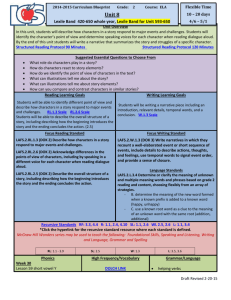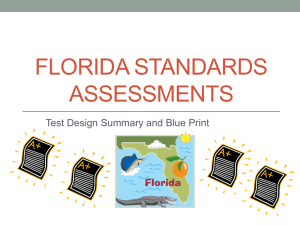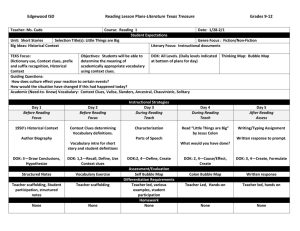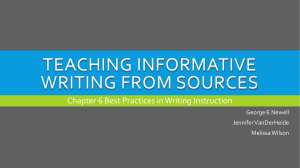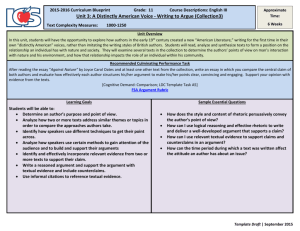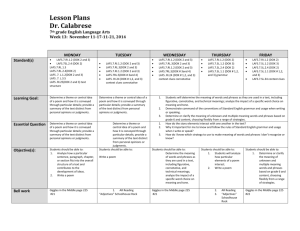2014-2015 Curriculum Blueprint Grade: 4 Course: ELA District Unit
advertisement
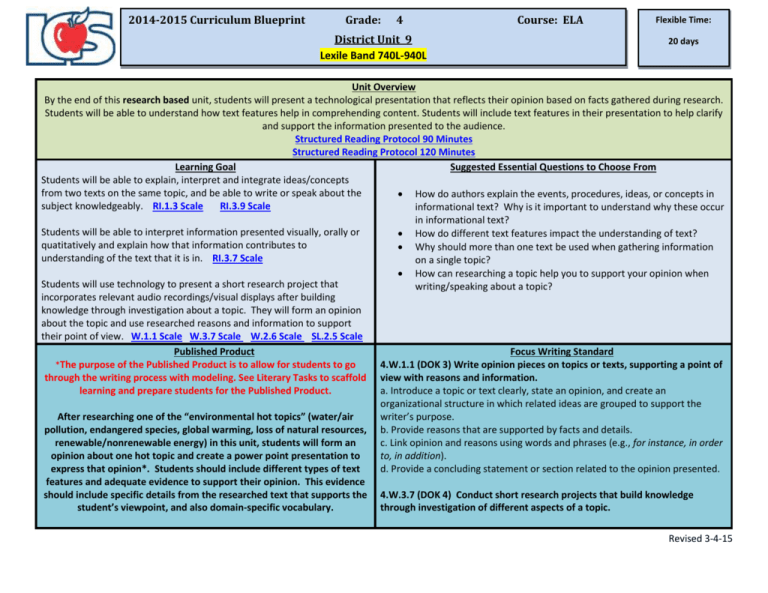
2014-2015 Curriculum Blueprint Grade: 4 District Unit 9 Lexile Band 740L-940L Course: ELA Flexible Time: 20 days Unit Overview By the end of this research based unit, students will present a technological presentation that reflects their opinion based on facts gathered during research. Students will be able to understand how text features help in comprehending content. Students will include text features in their presentation to help clarify and support the information presented to the audience. Structured Reading Protocol 90 Minutes Structured Reading Protocol 120 Minutes Learning Goal Suggested Essential Questions to Choose From Students will be able to explain, interpret and integrate ideas/concepts from two texts on the same topic, and be able to write or speak about the How do authors explain the events, procedures, ideas, or concepts in subject knowledgeably. RI.1.3 Scale RI.3.9 Scale informational text? Why is it important to understand why these occur in informational text? Students will be able to interpret information presented visually, orally or How do different text features impact the understanding of text? quatitatively and explain how that information contributes to Why should more than one text be used when gathering information understanding of the text that it is in. RI.3.7 Scale on a single topic? How can researching a topic help you to support your opinion when Students will use technology to present a short research project that writing/speaking about a topic? incorporates relevant audio recordings/visual displays after building knowledge through investigation about a topic. They will form an opinion about the topic and use researched reasons and information to support their point of view. W.1.1 Scale W.3.7 Scale W.2.6 Scale SL.2.5 Scale Published Product Focus Writing Standard *The purpose of the Published Product is to allow for students to go 4.W.1.1 (DOK 3) Write opinion pieces on topics or texts, supporting a point of through the writing process with modeling. See Literary Tasks to scaffold view with reasons and information. learning and prepare students for the Published Product. a. Introduce a topic or text clearly, state an opinion, and create an organizational structure in which related ideas are grouped to support the After researching one of the “environmental hot topics” (water/air writer’s purpose. pollution, endangered species, global warming, loss of natural resources, b. Provide reasons that are supported by facts and details. renewable/nonrenewable energy) in this unit, students will form an c. Link opinion and reasons using words and phrases (e.g., for instance, in order opinion about one hot topic and create a power point presentation to to, in addition). express that opinion*. Students should include different types of text d. Provide a concluding statement or section related to the opinion presented. features and adequate evidence to support their opinion. This evidence should include specific details from the researched text that supports the 4.W.3.7 (DOK 4) Conduct short research projects that build knowledge student’s viewpoint, and also domain-specific vocabulary. through investigation of different aspects of a topic. Revised 3-4-15 *Example of an opinion that a student could use: Farmers should be required to grow organic, non-GMO crops. OR It should not be required for consumers to use renewable energy. 4.W.2.6 (DOK 2) With some guidance and support from adults, use technology, including the Internet, to produce and publish writing as well as to interact and collaborate with others. Recursive Standards to be Embedded in Instruction * McGraw Hill Wonders series may be used to teach the following: Foundational Skills, Speaking and Listening, Writing and Language, Grammar, and Spelling Recursive Standards The above link is a listing of standards that should be addressed throughout the year, while instructing the weekly standards. Focus Reading Standards LAFS.4.RI.1.3 (DOK 3) Explain events, procedures, ideas, or concepts in a historical, scientific, or technical text, including what happened and why, based on specific information in the text. Identify events, procedures, ideas, and concepts. Identify character interaction led to events. Evaluate why events, procedures, ideas, and concepts occurred with supporting details. Summarize why events, procedures, ideas, and concepts occurred with supporting details. 3rd: Describe the relationship between a series of historical events, scientific ideas or concepts, or steps in technical procedures in a text, using language that pertains to time, sequence, and cause/effect. 5th: Explain the relationships or interactions between two or more individuals, events, ideas, or concepts in a historical, scientific, or technical text based on specific information in the text. LAFS.4.RI.3.7 (DOK 3) Interpret information presented visually, orally, or quantitatively (e.g., in charts, graphs, diagrams, time lines, animations, or interactive elements on Web pages) and explain how the information contributes to an understanding of the text in which it appears. Define interpret. Recognize nonfiction text features. Read graphs, charts, diagram, timelines, etc. Recognize interactive Web elements. Analyze information from charts, diagrams, graphs, timelines, animations, and interactive elements. Analyze information visually, orally, and quantitatively. Evaluate how information presented visually, orally, and quantitatively aids in understanding. 3rd: Use information gained from illustrations (e.g., maps, photographs) and the words in a text to demonstrate understanding of the text (e.g., where, when, why, and how key events occur). 5th: Draw on information from multiple print or digital sources, demonstrating the ability to locate an answer to a question quickly or to solve a problem efficiently LAFS.4.RI.3.9 (DOK 3) Integrate information from two texts on the same topic in order to write or speak about the subject knowledgeably. Identify information within texts on the same topic. Integrate information from two texts on the same topic. 3rd: Compare and contrast the most important points and key details presented in two texts on the same topic. 5th: Integrate information from several texts on the same topic in order to write or speak about the subject knowledgeably. Revised 3-4-15 Focus Speaking and Listening Standards LAFS.4 SL.2.5 (DOK 3) Add audio recordings and visual displays to presentations when appropriate to enhance the development of main ideas or themes. Suggested Informational Texts Unit Assesement FL Ready book pages 51-56 Teach and Model Everglades DBQ Apply with Close Reading - The Short Hard Life of a Male Florida Panther - Florida Frantically Rounds Up Tegu Lizards Which Are Eating Everything Up No Map Or GPS, Sea Turtles Still Swim Thousands Of Miles Home Audio/Multimedia Presentations to Address RI.3.7 Bill Nye the Science Guy: Renewable Energy The Water Project video on water cycle Bill Nye the Science Guy: Genetically Modified Foods Tools and Resources for Finding Optional Texts Science Texts: When applicable Social Studies Texts: When applicable Document-Based Questions (DBQs) This link will direct you to login to Moodle to access all DBQ documents login/password is your district login/password NEWSELA Focus Language Standards LAFS.4.L.3.5 Demonstrate understanding of word relationships, and nuances in word meanings. a. Explain the meaning of simple similes and metaphors (e.g., as pretty as a picture) in context. b. Recognize and explain the meaning of common idioms, adages, and proverbs. c. Demonstrate understanding of words by relating them to their opposites (antonyms) and to words with similar but not identical meanings (synonyms). LAFS.4.L.3.6 Acquire and use accurately general academic and domain-specific words and phrases as found in grade level appropriate texts, including those that signal precise actions, emotions, or states of being. Literary Tasks *Choose at least 1 task per standard that will support and scaffold learning for the published product. Can be used in whole group, small group, and journal responses. LDC 4-5 Template Tasks LAFS.4.RI.1.3 (DOK 3) After reading Energy Island, explain how the details in the sidebars help to explain the differences between renewable and nonrenewable energy. LAFS.4.RI.1.3 (DOK 3) After reading A Drop of Water, re-read pages 434-435. Work with a partner to write an explanation about the relationship between condensation and evaporation. LAFS.4.RI.3.7 (DOK 3) After reading a teacher selected nonfiction text, discuss with a partner what text features were used to present the information. Why did the author include the picture on specific pages? How did it help you better understand the information presented in the text. LAFS.4.3.7 (DOK 3) After reading a text and a video with similar content, use a Thinking Map/graphic organizer to identify similarities and differences in the information presented in the two versions. LAFS.4.RI.3.9 (DOK 3) After reading Food Fight and A New Kind of Corn, use a Thinking Map/graphic organizer to compare and contrast the viewpoints of each Revised 3-4-15 NEWSELA is an innovative way to build reading comprehension with nonfiction that's always relevant: daily news. Lexile is adjustable within text. ebscohost Under this link, use “Searchasaurus” Login/Password is lakecounty lexile.com Lexile.com serves as a tool to assist teachers with verifying reading sources for curriculum support. Tools to measure text complexity (Vetting a text) author. Does one text provide more convincing evidence for or against genetically modifying food? LAFS.4.RI.3.9 (DOK 3) After reading A Drop of Water and Why is Everyone Worried About Global Warming?, have a class discussion on how global warming could affect the water cycle. ***A limited amount of tasks were provided, as students should have sufficient time to research and create their published product during this unit*** **During this unit, students will research a topic and present their opinion *The tasks provided are a sampling. Therefore, additional tasks would be through the use of technology. The list of texts and links above is only a required to ensure adequate practice and deepening of knowledge to ensure sample of resources. Students should be given classroom time to research mastery of the focus standards. information and create their presentation. *Students should interact with the suggested/optional texts multiple times to master the three focus reading standards within this unit. PLC’s should collaborate to determine the order of instruction and strategies that support the learning goal. Revised 3-4-15 Higher Order Questions Link to Webb’s DOK Guide *Question stems should be utilized to create text dependent questions to encourage close reading, speaking, listening, and writing throughout the unit. 4.RI.1.3 (DOK 3) 4.RI.3.7 (DOK 3) 4.RI.3.9 (DOK 3) *How did __ play a role in the events that *How does the __ (graph/chart/diagram/timeline) *What are the similarities and differences in how occurred? contribute to the understanding of the text? Use the information is developed in the texts? examples from the text features to communicate * Explain why __occurs/occurred with details from your reasoning. *What general information do the authors give on the text __? *What inference can you make based on the *What events led to __? graph/chart/diagram/timeline? *How does each author go in depth with the concept/event? *What ideas let to__? *What new information have you gained as a result of the text feature/interactive element? *What information gathered from the sources is *What relevant details would be included in a important enough to include in your writing or summary of __? *What information can the reader can gain from presentation? the text feature that is not discussed in the article? *Which statement explains why___? Which *How can you integrate the information from the sentence from the article supports your answer? two texts to explain __? *How is the information in both articles similarly presented by the authors? Additional Resources & Links Marzano Proficiency Scales Bank Writing Rubric – Informative/Explanatory Writing Rubric - Opinion Student Writing Examples by Grade Level FSA Test Item Specifications 3rd Grade ELA Test Item Specifications 4th Grade ELA Test Item Specifications 5th Grade ELA Test Item Specifications Revised 3-4-15





